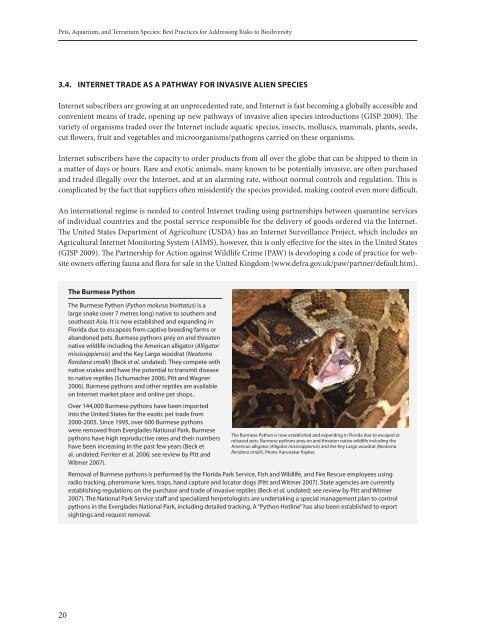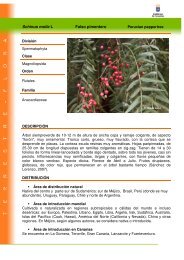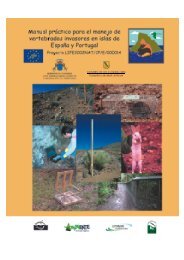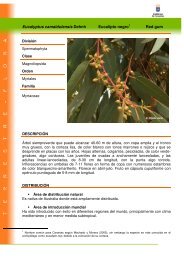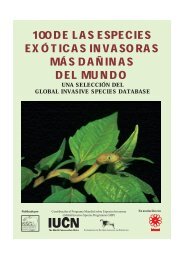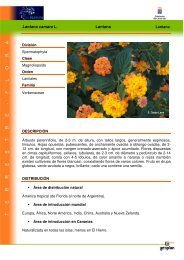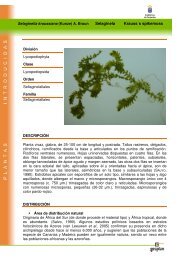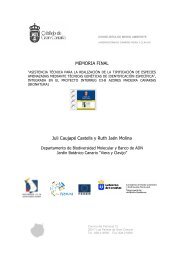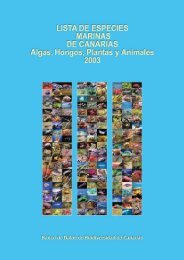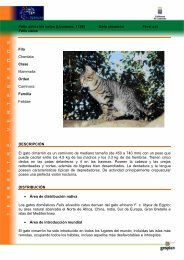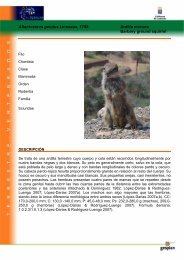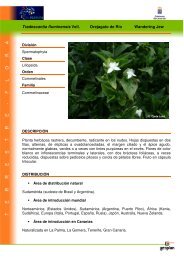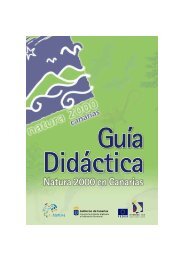Pets, Aquarium, and Terrarium Species - Convention on Biological ...
Pets, Aquarium, and Terrarium Species - Convention on Biological ...
Pets, Aquarium, and Terrarium Species - Convention on Biological ...
You also want an ePaper? Increase the reach of your titles
YUMPU automatically turns print PDFs into web optimized ePapers that Google loves.
<str<strong>on</strong>g>Pets</str<strong>on</strong>g>, <str<strong>on</strong>g>Aquarium</str<strong>on</strong>g>, <str<strong>on</strong>g>and</str<strong>on</strong>g> <str<strong>on</strong>g>Terrarium</str<strong>on</strong>g> <str<strong>on</strong>g>Species</str<strong>on</strong>g>: Best Practices for Addressing Risks to Biodiversity<br />
3.4. Internet Trade as a Pathway for Invasive Alien <str<strong>on</strong>g>Species</str<strong>on</strong>g><br />
Internet subscribers are growing at an unprecedented rate, <str<strong>on</strong>g>and</str<strong>on</strong>g> Internet is fast becoming a globally accessible <str<strong>on</strong>g>and</str<strong>on</strong>g><br />
c<strong>on</strong>venient means of trade, opening up new pathways of invasive alien species introducti<strong>on</strong>s (GISP 2009). The<br />
variety of organisms traded over the Internet include aquatic species, insects, molluscs, mammals, plants, seeds,<br />
cut flowers, fruit <str<strong>on</strong>g>and</str<strong>on</strong>g> vegetables <str<strong>on</strong>g>and</str<strong>on</strong>g> microorganisms/pathogens carried <strong>on</strong> these organisms.<br />
Internet subscribers have the capacity to order products from all over the globe that can be shipped to them in<br />
a matter of days or hours. Rare <str<strong>on</strong>g>and</str<strong>on</strong>g> exotic animals, many known to be potentially invasive, are often purchased<br />
<str<strong>on</strong>g>and</str<strong>on</strong>g> traded illegally over the Internet, <str<strong>on</strong>g>and</str<strong>on</strong>g> at an alarming rate, without normal c<strong>on</strong>trols <str<strong>on</strong>g>and</str<strong>on</strong>g> regulati<strong>on</strong>. This is<br />
complicated by the fact that suppliers often misidentify the species provided, making c<strong>on</strong>trol even more difficult.<br />
An internati<strong>on</strong>al regime is needed to c<strong>on</strong>trol Internet trading using partnerships between quarantine services<br />
of individual countries <str<strong>on</strong>g>and</str<strong>on</strong>g> the postal service resp<strong>on</strong>sible for the delivery of goods ordered via the Internet.<br />
The United States Department of Agriculture (USDA) has an Internet Surveillance Project, which includes an<br />
Agricultural Internet M<strong>on</strong>itoring System (AIMS), however, this is <strong>on</strong>ly effective for the sites in the United States<br />
(GISP 2009). The Partnership for Acti<strong>on</strong> against Wildlife Crime (PAW) is developing a code of practice for website<br />
owners offering fauna <str<strong>on</strong>g>and</str<strong>on</strong>g> flora for sale in the United Kingdom (www.defra.gov.uk/paw/partner/default.htm).<br />
The Burmese Pyth<strong>on</strong><br />
The Burmese Pyth<strong>on</strong> (Pyth<strong>on</strong> molurus bivittatus) is a<br />
large snake (over 7 metres l<strong>on</strong>g) native to southern <str<strong>on</strong>g>and</str<strong>on</strong>g><br />
southeast Asia. It is now established <str<strong>on</strong>g>and</str<strong>on</strong>g> exp<str<strong>on</strong>g>and</str<strong>on</strong>g>ing in<br />
Florida due to escapees from captive breeding farms or<br />
ab<str<strong>on</strong>g>and</str<strong>on</strong>g><strong>on</strong>ed pets. Burmese pyth<strong>on</strong>s prey <strong>on</strong> <str<strong>on</strong>g>and</str<strong>on</strong>g> threaten<br />
native wildlife including the American alligator (Alligator<br />
mississippiensis) <str<strong>on</strong>g>and</str<strong>on</strong>g> the Key Largo woodrat (Neotoma<br />
floridana smalli) (Beck et al. undated). They compete with<br />
native snakes <str<strong>on</strong>g>and</str<strong>on</strong>g> have the potential to transmit disease<br />
to native reptiles (Schumacher 2006; Pitt <str<strong>on</strong>g>and</str<strong>on</strong>g> Wagner<br />
2006). Burmese pyth<strong>on</strong>s <str<strong>on</strong>g>and</str<strong>on</strong>g> other reptiles are available<br />
<strong>on</strong> Internet market place <str<strong>on</strong>g>and</str<strong>on</strong>g> <strong>on</strong>line pet shops..<br />
Over 144,000 Burmese pyth<strong>on</strong>s have been imported<br />
into the United States for the exotic pet trade from<br />
2000-2005. Since 1995, over 600 Burmese pyth<strong>on</strong>s<br />
were removed from Everglades Nati<strong>on</strong>al Park. Burmese<br />
pyth<strong>on</strong>s have high reproductive rates <str<strong>on</strong>g>and</str<strong>on</strong>g> their numbers<br />
have been increasing in the past few years (Beck et<br />
al. undated; Ferriter et al. 2006; see review by Pitt <str<strong>on</strong>g>and</str<strong>on</strong>g><br />
Witmer 2007).<br />
The Burmese Pyth<strong>on</strong> is now established <str<strong>on</strong>g>and</str<strong>on</strong>g> exp<str<strong>on</strong>g>and</str<strong>on</strong>g>ing in Florida due to escaped or<br />
released pets. Burmese pyth<strong>on</strong>s prey <strong>on</strong> <str<strong>on</strong>g>and</str<strong>on</strong>g> threaten native wildlife including the<br />
American alligator (Alligator mississippiensis) <str<strong>on</strong>g>and</str<strong>on</strong>g> the Key Largo woodrat (Neotoma<br />
floridana smalli). Photo: Karunakar Rayker.<br />
Removal of Burmese pyth<strong>on</strong>s is performed by the Florida Park Service, Fish <str<strong>on</strong>g>and</str<strong>on</strong>g> Wildlife, <str<strong>on</strong>g>and</str<strong>on</strong>g> Fire Rescue employees using<br />
radio tracking, pherom<strong>on</strong>e lures, traps, h<str<strong>on</strong>g>and</str<strong>on</strong>g> capture <str<strong>on</strong>g>and</str<strong>on</strong>g> locator dogs (Pitt <str<strong>on</strong>g>and</str<strong>on</strong>g> Witmer 2007). State agencies are currently<br />
establishing regulati<strong>on</strong>s <strong>on</strong> the purchase <str<strong>on</strong>g>and</str<strong>on</strong>g> trade of invasive reptiles (Beck et al. undated; see review by Pitt <str<strong>on</strong>g>and</str<strong>on</strong>g> Witmer<br />
2007). The Nati<strong>on</strong>al Park Service staff <str<strong>on</strong>g>and</str<strong>on</strong>g> specialized herpetologists are undertaking a special management plan to c<strong>on</strong>trol<br />
pyth<strong>on</strong>s in the Everglades Nati<strong>on</strong>al Park, including detailed tracking. A “Pyth<strong>on</strong> Hotline” has also been established to report<br />
sightings <str<strong>on</strong>g>and</str<strong>on</strong>g> request removal.<br />
20


